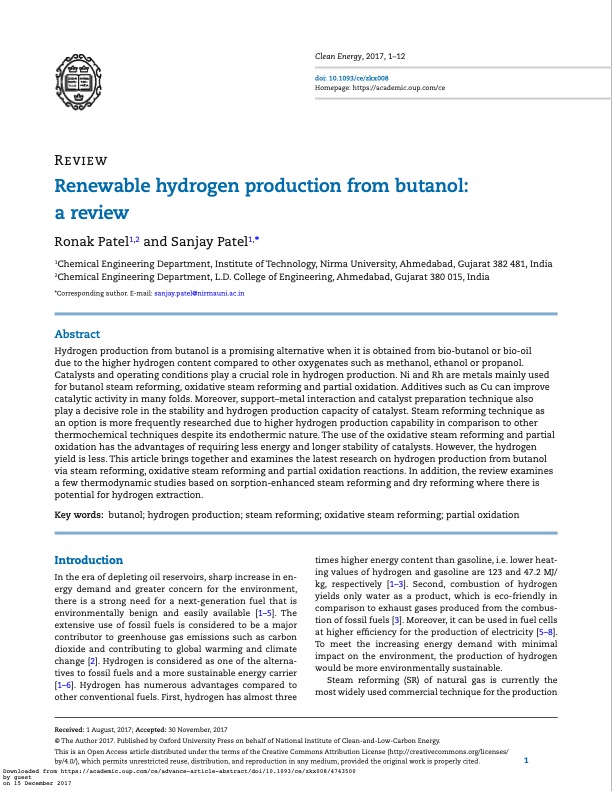
PDF Publication Title:
Text from PDF Page: 001
Renewable hydrogen production from butanol: a review Ronak Patel1,2 and Sanjay Patel1,* 1Chemical Engineering Department, Institute of Technology, Nirma University, Ahmedabad, Gujarat 382 481, India 2Chemical Engineering Department, L.D. College of Engineering, Ahmedabad, Gujarat 380 015, India *Corresponding author. E-mail: sanjay.patel@nirmauni.ac.in Abstract Hydrogen production from butanol is a promising alternative when it is obtained from bio-butanol or bio-oil due to the higher hydrogen content compared to other oxygenates such as methanol, ethanol or propanol. Catalysts and operating conditions play a crucial role in hydrogen production. Ni and Rh are metals mainly used for butanol steam reforming, oxidative steam reforming and partial oxidation. Additives such as Cu can improve catalytic activity in many folds. Moreover, support–metal interaction and catalyst preparation technique also play a decisive role in the stability and hydrogen production capacity of catalyst. Steam reforming technique as an option is more frequently researched due to higher hydrogen production capability in comparison to other thermochemical techniques despite its endothermic nature. The use of the oxidative steam reforming and partial oxidation has the advantages of requiring less energy and longer stability of catalysts. However, the hydrogen yield is less. This article brings together and examines the latest research on hydrogen production from butanol via steam reforming, oxidative steam reforming and partial oxidation reactions. In addition, the review examines a few thermodynamic studies based on sorption-enhanced steam reforming and dry reforming where there is potential for hydrogen extraction. Key words: butanol; hydrogen production; steam reforming; oxidative steam reforming; partial oxidation Clean Energy, 2017, 1–12 doi: 10.1093/ce/zkx008 Homepage: https://academic.oup.com/ce Review Introduction In the era of depleting oil reservoirs, sharp increase in en- ergy demand and greater concern for the environment, there is a strong need for a next-generation fuel that is environmentally benign and easily available [1–5]. The extensive use of fossil fuels is considered to be a major contributor to greenhouse gas emissions such as carbon dioxide and contributing to global warming and climate change [2]. Hydrogen is considered as one of the alterna- tives to fossil fuels and a more sustainable energy carrier [1–6]. Hydrogen has numerous advantages compared to other conventional fuels. First, hydrogen has almost three times higher energy content than gasoline, i.e. lower heat- ing values of hydrogen and gasoline are 123 and 47.2 MJ/ kg, respectively [1–3]. Second, combustion of hydrogen yields only water as a product, which is eco-friendly in comparison to exhaust gases produced from the combus- tion of fossil fuels [3]. Moreover, it can be used in fuel cells at higher efficiency for the production of electricity [5–8]. To meet the increasing energy demand with minimal impact on the environment, the production of hydrogen would be more environmentally sustainable. Steam reforming (SR) of natural gas is currently the most widely used commercial technique for the production Received: 1 August, 2017; Accepted: 30 November, 2017 © The Author 2017. Published by Oxford University Press on behalf of National Institute of Clean-and-Low-Carbon Energy. This is an Open Access article distributed under the terms of the Creative Commons Attribution License (http://creativecommons.org/licenses/ by/4.0/), which permits unrestricted reuse, distribution, and reproduction in any medium, provided the original work is properly cited. 1 Downloaded from https://academic.oup.com/ce/advance-article-abstract/doi/10.1093/ce/zkx008/4743500 by guest on 15 December 2017PDF Image | Renewable hydrogen production from butanol

PDF Search Title:
Renewable hydrogen production from butanolOriginal File Name Searched:
Renewable_hydrogen_production_from_butanol.pdfDIY PDF Search: Google It | Yahoo | Bing
NFT (Non Fungible Token): Buy our tech, design, development or system NFT and become part of our tech NFT network... More Info
IT XR Project Redstone NFT Available for Sale: NFT for high tech turbine design with one part 3D printed counter-rotating energy turbine. Be part of the future with this NFT. Can be bought and sold but only one design NFT exists. Royalties go to the developer (Infinity) to keep enhancing design and applications... More Info
Infinity Turbine IT XR Project Redstone Design: NFT for sale... NFT for high tech turbine design with one part 3D printed counter-rotating energy turbine. Includes all rights to this turbine design, including license for Fluid Handling Block I and II for the turbine assembly and housing. The NFT includes the blueprints (cad/cam), revenue streams, and all future development of the IT XR Project Redstone... More Info
Infinity Turbine ROT Radial Outflow Turbine 24 Design and Worldwide Rights: NFT for sale... NFT for the ROT 24 energy turbine. Be part of the future with this NFT. This design can be bought and sold but only one design NFT exists. You may manufacture the unit, or get the revenues from its sale from Infinity Turbine. Royalties go to the developer (Infinity) to keep enhancing design and applications... More Info
Infinity Supercritical CO2 10 Liter Extractor Design and Worldwide Rights: The Infinity Supercritical 10L CO2 extractor is for botanical oil extraction, which is rich in terpenes and can produce shelf ready full spectrum oil. With over 5 years of development, this industry leader mature extractor machine has been sold since 2015 and is part of many profitable businesses. The process can also be used for electrowinning, e-waste recycling, and lithium battery recycling, gold mining electronic wastes, precious metals. CO2 can also be used in a reverse fuel cell with nafion to make a gas-to-liquids fuel, such as methanol, ethanol and butanol or ethylene. Supercritical CO2 has also been used for treating nafion to make it more effective catalyst. This NFT is for the purchase of worldwide rights which includes the design. More Info
NFT (Non Fungible Token): Buy our tech, design, development or system NFT and become part of our tech NFT network... More Info
Infinity Turbine Products: Special for this month, any plans are $10,000 for complete Cad/Cam blueprints. License is for one build. Try before you buy a production license. May pay by Bitcoin or other Crypto. Products Page... More Info
| CONTACT TEL: 608-238-6001 Email: greg@infinityturbine.com | RSS | AMP |